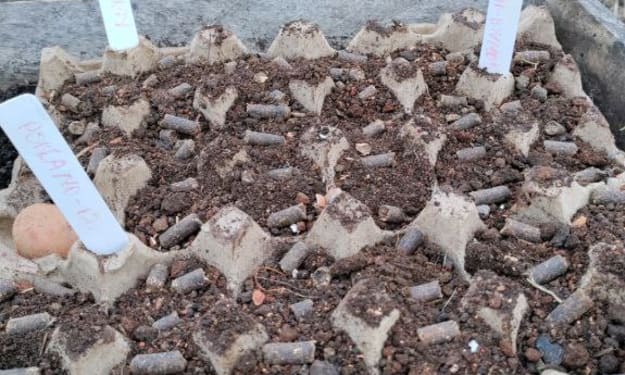Unconventional Path
Growing Your Own Sustenance

Being a native Las Vegan, the act of gardening is not the customary way of life. The arid desert climate and stony soil render it arduous to cultivate anything substantial. It took me quite some time to apprehend the advantages and potential of growing my own sustenance. Thus, I decided to plunge headfirst and abandon my sole reliance on grocery stores, opting for a change. The desire for self-sufficiency and food cultivation consumed me. Finally settling into a dwelling with a yard, I embarked on extensive research, procured books on homesteading, and ultimately resolved to take the leap.
As a beginner, I had an abundance to absorb, but I swiftly unearthed that subsisting off one's own harvest and livestock is plausible. However, it necessitates immense toil and unyielding dedication. Ergo, I yearned to impart some of the knowledge I acquired about growing one's sustenance and the quantity required to sustain oneself.
The quantity of food one can cultivate hinges on various factors such as climate, soil quality, and land size. In the case of Las Vegas, the parched desert climate and stony soil make bountiful growth a formidable task. Hence, when I decided to undertake food cultivation, I had to commence by calculating the amount of food I would require to sustain myself.
To decipher this conundrum, I commenced maintaining a food diary, meticulously documenting the ingredients and their respective quantities utilized in my meals. This meticulous record-keeping unveiled that approximately two pounds of vegetables per day were necessary to maintain a wholesome diet. Naturally, this may fluctuate depending on caloric requirements, but I employed it as my point of embarkation. Thus, it became evident that I needed to cultivate roughly 730 pounds of vegetables annually to satiate my sustenance.
Cultivating enough food to sustain oneself throughout the year is no mean feat. Strategic planning spanning from planting to harvesting is indispensable to guarantee a constant supply of diverse, fresh vegetables year-round. I rapidly comprehended the significance of timing. In Las Vegas, the crux lies in planting during spring and summer when the growing season is fleeting due to the relentless heat.
To secure an uninterrupted supply of vegetables throughout the year, I invested in cold frames, which elongated the growing season well into the winter months. Cold frames prove effortless to use and provide protection against extreme weather conditions such as frost and tempestuous winds.
In addition to cultivating vegetables, I also reared chickens for their eggs and meat. Analogous to vegetable cultivation, animal husbandry mandates meticulous planning. In the case of chickens, I discovered that four to six hens sufficed to cater to my personal egg requirements. However, if one intends to vend eggs or rear chickens for meat, a larger flock may be imperative.
Rearing chickens necessitates constructing a well-fortified coop and run to fend off predators. Regular feeding and provision of water are paramount, and the living area must be perpetually clean to avert the onset of diseases and ailments.
One boon of rearing chickens is their production of invaluable fertilizer, which can be employed to enrich the garden soil and foster robust plant growth. Chicken manure boasts high nitrogen content and an array of other nutrients, rendering it an impeccable choice for soil enrichment.
In addition to chickens, I briefly reared goats for milk, cheese, and meat, as my interests yearned to explore other avenues. Goats require more space than chickens and necessitate a secure enclosure. Regular feeding and provision of clean water are imperative as well.
Rearing goats provides an excellent means of producing one's milk and dairy products, but it mandates profound knowledge and expertise. Goats must be milked on a regular basis, and the milk must be handled and stored meticulously to stave off spoilage and contamination.
If one yearns to delve into animal husbandry, prudent research and meticulous planning become imperative to cater to their needs and safeguard their health and well-being. This encompasses delving into the specific requirements of the desired animal and acquainting oneself with any local laws or regulations governing animal husbandry.
Beside the pragmatic aspects of nurturing creatures, it is crucial to contemplate the moral ramifications. Animals embody life, and nurturing them for sustenance or alternative objectives necessitates a genuine devotion to their well-being and guardianship.
On the whole, cultivating crops and creatures can be an enriching and gratifying voyage. It demands meticulous planning and ardor, yet the outcome can yield a bountiful supply of invigorating, nourishing sustenance for you and your kin. Armed with the appropriate wisdom and means, anyone can acquire the skills to generate their own sustenance and embrace a more sustainable and autonomous way of life.
۞۞۞۞۞
Original story (created by me) published on Medium.com. Any changes and/or updates that have been added on Vocal.media are for content consumption purposes.
Thank you for your time, I hope you thoroughly enjoyed what you have read today. Please subscribe. I have plenty of upcoming articles on varying topics, if you so choose to check them out. Also if you would be so kind, I would greatly appreciate a heart. Lastly, if you feel inclined to do so, tips and of course pledges (currently only $2.99 a month) are greatly appreciated. Our monies collected in Vocal help support the Bunong tribal people in Cambodia.
About the Creator
Freddie's Lost Treasures
A traveler in search of lost and hidden treasures. I have assembled a lifelong learning of being in the business world and decided to take a leap to see what is outside the confines of brick and mortar and left the 9 to 5 behind.






Comments
There are no comments for this story
Be the first to respond and start the conversation.